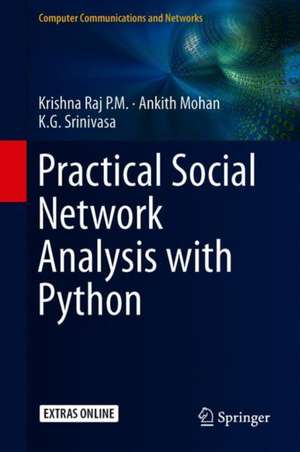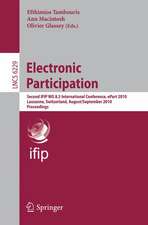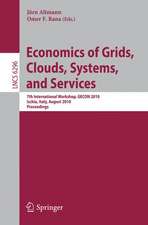Practical Social Network Analysis with Python: Computer Communications and Networks
Autor Krishna Raj P.M., Ankith Mohan, K.G. Srinivasaen Limba Engleză Hardback – 14 sep 2018
With the Internet becoming part of our everyday lives, social networking tools are used as the primary means of communication. And as the volume and speed of such data is increasing rapidly, there is a need to apply computational techniques to interpret and understand it. Moreover, relationships in molecular structures, co-authors in scientific journals, and developers in a software community can also be understood better by visualising them as networks.
This book brings together the theory and practice of social network analysis and includes mathematical concepts, computational techniques and examples from the real world to offer readers an overview of this domain.
| Toate formatele și edițiile | Preț | Express |
|---|---|---|
| Paperback (1) | 598.69 lei 38-44 zile | |
| Springer International Publishing – 8 feb 2019 | 598.69 lei 38-44 zile | |
| Hardback (1) | 850.33 lei 38-44 zile | |
| Springer International Publishing – 14 sep 2018 | 850.33 lei 38-44 zile |
Din seria Computer Communications and Networks
- 20%
 Preț: 378.19 lei
Preț: 378.19 lei - 20%
 Preț: 684.74 lei
Preț: 684.74 lei - 20%
 Preț: 218.22 lei
Preț: 218.22 lei - 20%
 Preț: 1013.39 lei
Preț: 1013.39 lei - 20%
 Preț: 368.78 lei
Preț: 368.78 lei - 20%
 Preț: 505.49 lei
Preț: 505.49 lei - 20%
 Preț: 646.80 lei
Preț: 646.80 lei - 20%
 Preț: 609.09 lei
Preț: 609.09 lei - 20%
 Preț: 765.60 lei
Preț: 765.60 lei - 20%
 Preț: 339.47 lei
Preț: 339.47 lei - 20%
 Preț: 597.29 lei
Preț: 597.29 lei - 20%
 Preț: 655.85 lei
Preț: 655.85 lei - 20%
 Preț: 997.06 lei
Preț: 997.06 lei - 20%
 Preț: 351.89 lei
Preț: 351.89 lei - 20%
 Preț: 902.04 lei
Preț: 902.04 lei - 20%
 Preț: 996.22 lei
Preț: 996.22 lei - 20%
 Preț: 644.81 lei
Preț: 644.81 lei - 15%
 Preț: 650.69 lei
Preț: 650.69 lei - 20%
 Preț: 650.73 lei
Preț: 650.73 lei - 20%
 Preț: 373.91 lei
Preț: 373.91 lei - 20%
 Preț: 646.95 lei
Preț: 646.95 lei - 20%
 Preț: 1004.99 lei
Preț: 1004.99 lei - 20%
 Preț: 646.80 lei
Preț: 646.80 lei - 20%
 Preț: 341.81 lei
Preț: 341.81 lei - 20%
 Preț: 656.19 lei
Preț: 656.19 lei - 20%
 Preț: 651.75 lei
Preț: 651.75 lei - 20%
 Preț: 331.08 lei
Preț: 331.08 lei - 20%
 Preț: 650.40 lei
Preț: 650.40 lei - 20%
 Preț: 988.66 lei
Preț: 988.66 lei - 20%
 Preț: 643.97 lei
Preț: 643.97 lei - 20%
 Preț: 761.44 lei
Preț: 761.44 lei - 20%
 Preț: 332.71 lei
Preț: 332.71 lei - 20%
 Preț: 345.59 lei
Preț: 345.59 lei - 20%
 Preț: 332.06 lei
Preț: 332.06 lei - 20%
 Preț: 996.22 lei
Preț: 996.22 lei - 20%
 Preț: 644.15 lei
Preț: 644.15 lei - 20%
 Preț: 326.64 lei
Preț: 326.64 lei - 20%
 Preț: 320.19 lei
Preț: 320.19 lei - 20%
 Preț: 1013.06 lei
Preț: 1013.06 lei - 20%
 Preț: 642.52 lei
Preț: 642.52 lei - 20%
 Preț: 641.01 lei
Preț: 641.01 lei - 20%
 Preț: 718.56 lei
Preț: 718.56 lei - 20%
 Preț: 1043.41 lei
Preț: 1043.41 lei
Preț: 850.33 lei
Preț vechi: 1062.92 lei
-20% Nou
Puncte Express: 1275
Preț estimativ în valută:
162.73€ • 176.70$ • 136.69£
162.73€ • 176.70$ • 136.69£
Carte tipărită la comandă
Livrare economică 18-24 aprilie
Preluare comenzi: 021 569.72.76
Specificații
ISBN-13: 9783319967455
ISBN-10: 3319967452
Pagini: 435
Ilustrații: XXXI, 329 p. 186 illus., 73 illus. in color. With online files/update.
Dimensiuni: 155 x 235 x 27 mm
Ediția:1st ed. 2018
Editura: Springer International Publishing
Colecția Springer
Seria Computer Communications and Networks
Locul publicării:Cham, Switzerland
ISBN-10: 3319967452
Pagini: 435
Ilustrații: XXXI, 329 p. 186 illus., 73 illus. in color. With online files/update.
Dimensiuni: 155 x 235 x 27 mm
Ediția:1st ed. 2018
Editura: Springer International Publishing
Colecția Springer
Seria Computer Communications and Networks
Locul publicării:Cham, Switzerland
Cuprins
Chapter 1. Basics of Graph Theory.- Chapter 2. Graph Structure of the Web.- Chapter 3. Random Graph Models.- Chapter 4. Small World Phenomena.- Chapter 5. Graph Structure of Facebook.- Chapter 6. Peer-To-Peer Networks.- Chapter 7. Signed Networks.- Chapter 8. Cascading in Social Networks.- Chapter 9. Influence Maximisation.- Chapter 10. Outbreak Detection.- Chapter 11. Power Law.- Chapter 12. Kronecker Graphs.- Chapter 13. Link Analysis.- Chapter 14. Community Detection.- Chapter 15. Representation Learning on Graph.
Notă biografică
Dr. Krishna Raj P.M. is an Associate Professor at the Department of Information Science and Engineering at Ramaiah Institute of Technology, Bengaluru, India.
Mr. Ankith Mohan is a Research Associate at the same institution.
Dr. Srinivasa K.G. is an Associate Professor at the Department of Information Technology at Ch. Brahm Prakash Government Engineering College, Delhi, India.
Mr. Ankith Mohan is a Research Associate at the same institution.
Dr. Srinivasa K.G. is an Associate Professor at the Department of Information Technology at Ch. Brahm Prakash Government Engineering College, Delhi, India.
Textul de pe ultima copertă
This book focuses on social network analysis from a computational perspective, introducing readers to the fundamental aspects of network theory by discussing the various metrics used to measure the social network. It covers different forms of graphs and their analysis using techniques like filtering, clustering and rule mining, as well as important theories like small world phenomenon. It also presents methods for identifying influential nodes in the network and information dissemination models. Further, it uses examples to explain the tools for visualising large-scale networks, and explores emerging topics like big data and deep learning in the context of social network analysis.
With the Internet becoming part of our everyday lives, social networking tools are used as the primary means of communication. And as the volume and speed of such data is increasing rapidly, there is a need to apply computational techniques to interpret and understand it. Moreover, relationships in molecular structures, co-authors in scientific journals, and developers in a software community can also be understood better by visualising them as networks.
This book brings together the theory and practice of social network analysis and includes mathematical concepts, computational techniques and examples from the real world to offer readers an overview of this domain.
This book brings together the theory and practice of social network analysis and includes mathematical concepts, computational techniques and examples from the real world to offer readers an overview of this domain.
Caracteristici
Introduces the fundamentals of social network analysis Discusses key concepts and important analysis techniques Highlights, with real-world examples, how large networks can be analyzed using deep learning techniques



























